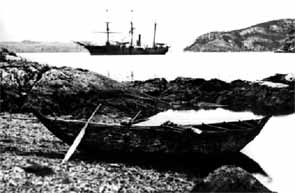| Chapter 7 The Perito Moreno Glacier FRANCISCO PANCRACIO MORENO |
|
|
One cold July morning of 1902, something strange happened at the door of the La Platt Museum, the most important Argentine center for Anthropology. An old man slowly descends the stone stairway of the entrance. He is completely nude, thin, and his skin is old but tanned by the sun. He kneels down on the entrance, stretches out his arms, and begins chanting in a strange language. Finally, he extends his body along the floor and the astonished witnesses verify he is dead. Its the Chieftain Shaihueque, the last indian to lay down his arms before the army of General Roca in 1880. Now, naked, free of all connection to the influence of the white man, he lies dead on the entrance of the famous institute that Perito Moreno directed. Even though twenty years ago they had been mortal enemies, Shaihueque had been taken to the museum by Moreno. From there on, Shaihueque counted many times on Moreno when he could no longer stand the abject humiliations to which this proud chief and his people were subject to as prisoners in Bahia Blanca. Moreno, on Shaihueque´s request, took him to the museum to live with him in La Plata. Although many times both men had been adversaries, they had for each other a profound respect. With time, Moreno, the advocate of civilization, came to understand the customs and ways of the indians. Also, he regretted the suffering inflicted upon these people on the grounds that they were being civilized. The reason for the high regard that Moreno has in history has to do with the tireless and unremitting work that he carried out all his life. |
To his understanding, the Patagonia was a true promised land of wealth and resources that could be exploited and used for enhancing its population with a high quality of life.
In the pursuit of developing these opportunities, Moreno directed all his efforts as an explorer, geographer, and anthropologist. And like Piedra Buena, he did not doubt in sacrificing his life for his lifelong aspirations and ideals. Moreno understood his scientific activity as a practical discipline to develop further the resources at hand. In 1879, in one of his expeditions, Moreno was captured by Shaihueque and managed to escape in a spectacular breakout. First he had to convince his foes that his death would bring them bad luck. Then, he waited three days, saw his chance when most of the indians were drunk, and, finally, stole a horse for the getaway. A few days later, he constructed a small raft and his pursuers lost his trail on the wild and dangerous rapids of the area. His escape ended safely at an army post. Moreno´s devotion to investigation and science was such that even as he was being pursued and with his life at risk, he still could not |
